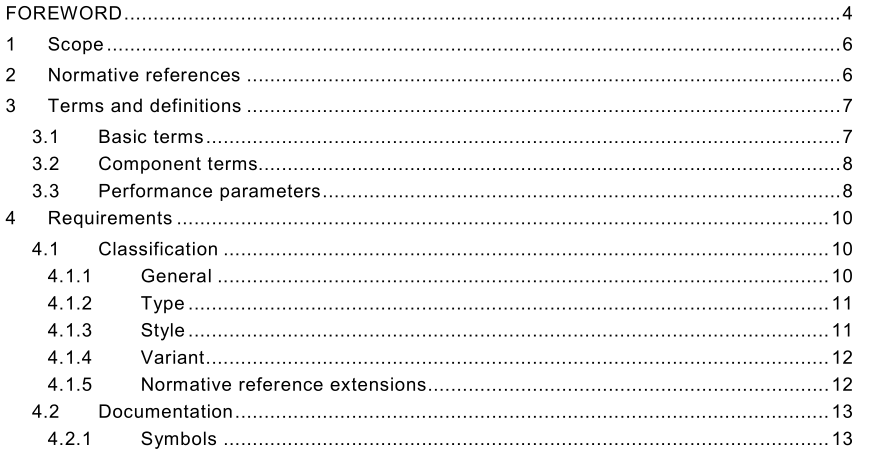IEC 62077-2015 pdf Fibre optic interconnecting devices and passive components – Fibre optic circulators – Generic specification

4.2.2.2 Blank detail specifications The blank detail specification lists all of the parameters and features applicable to a fibre optic circulator, including the type, operating characteristics, housing configurations, test methods, and performance requirements. The blank detail specification is applicable to any fibre optic circulator design and quality assessment requirement. The blank detail specification contains the preferred format for stating the required information in the detail specification. Blank detail specifications are not, by themselves, a specification level. They are associated with the generic specification. Each blank detail specification shall be limited to one environmental category. Each blank detail specification shall contain: – the minimum mandatory test schedules and performance requirements, – the preferred format for stating the required information in the detail specification, – in case of hybrid components, including connectors, addition of appropriate entry fields to show the reference normative document, document title and issue date.
Interface standards provide both manufacturer and user with all the information required to make or use the product in conformity with the physical features of that standard interface. Interface standards fully define the features essential for the mating and unmating of optical fibre connectors and other components. They also serve to position the optical datum target, where defined, relative to other reference datum. Interface standards ensure that connectors and adapters that comply with the standard will fit together. The standards may also contain tolerance grades for ferrules and alignment devices. Tolerance grades are used to provide different levels of alignment precision. The interface dimensions may also be used to design other components that will mate with the connectors. For example, an active device mount can be designed using the adapter interface dimensions. The use of these dimensions combined with those of a standard plug provides the designer with assurance that the standard plugs will fit into the optical device mount. They also provide the location of the plug’s optical datum target.
- ISO IEC 27050-4-2021 pdf Information technology — Electronic discovery — Part 4: Technical readiness
- ISO IEC 27036-1-2021 pdf Cybersecurity — Supplier relationships — Part 1: Overview and concepts
- ISO IEC 27013-2021 pdf Information security, cybersecurity and privacy protection — Guidance on the integrated implementation of ISO/IEC 27001 and ISO/IEC 20000-1
- ISO IEC 26580-2021 pdf Software and systems engineering — Methods and tools for the feature- based approach to software and systems product line engineering
- ISO IEC 24735-2021 pdf Information technology — Office equipment — Method for measuring digital copying productivity
- ISO IEC 24711-2021 pdf Information technology — Office equipment — Method for the determination of ink cartridge yield for colour inkjet printers and multi- function devices that contain printer components
- ISO IEC 23544-2021 pdf Information Technology — Data centres — Application Platform Energy Effectiveness (APEE)
- ISO IEC 23510-2021 pdf Information technology — 3D printing and scanning — Framework for an Additive Manufacturing Service Platform (AMSP)
- ISO IEC 23127-1-2021 pdf Information technology — Learning, education, and training — Metadata for facilitators of online learning — Part 1: Framework
- ISO IEC 23126-2021 pdf Information technology for learning, education and training — Ubiquitous learning resource organization and description framework
- BS IEC 60860-2014 pdf Radiation protection instrumentation一 Warning equipment for criticality accidents
- IEC PAS 63313-2021 pdf Position statement on germicidal UV-C irradiation UV-C safety guidelines
- IEC TS 62796-2013 pdf Energy efficiency in electroheating installations
- IEC 60317-20-2013 pdf Specifications for particular types of winding wires – Part 20: Solderable polyurethane enamelled round copper wire, class 155
- IEC 60974-8-2021 pdf Arc welding equipment – Part 8: Gas consoles for welding and plasma cutting systems
- BS ISO IEC 15420-2009 pdf Information technology一 Automatic identification and data capture techniques EAN/UPC bar code symbology specification
- BS ISO IEC 19762.5-2008 pdf Information technology一 Automatic identification and data capture (AIDC) techniques – Harmonized vocabulary Part 5: Locating systems
- BS IEC 60860-2014 pdf Radiation protection instrumentation一 Warning equipment for criticality accidents
- ISO IEC 24735-2021 pdf Information technology — Office equipment — Method for measuring digital copying productivity
- ISO IEC 24711-2021 pdf Information technology — Office equipment — Method for the determination of ink cartridge yield for colour inkjet printers and multi- function devices that contain printer components